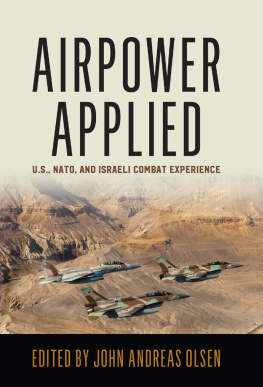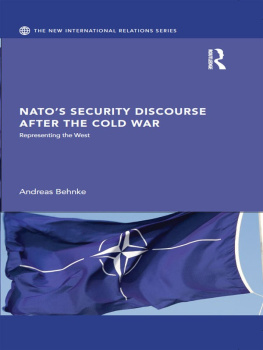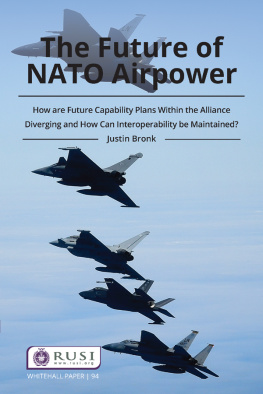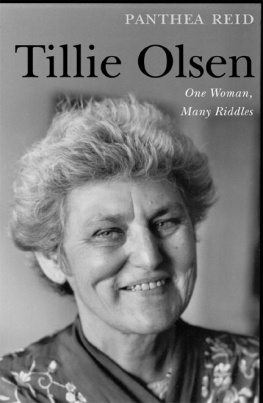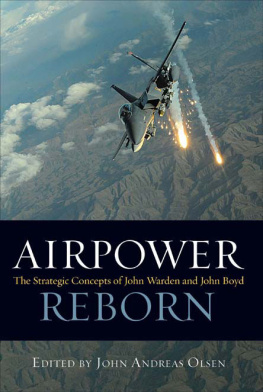John Andreas Olsen - Airpower applied : U.S., NATO, and Israeli combat experience
Here you can read online John Andreas Olsen - Airpower applied : U.S., NATO, and Israeli combat experience full text of the book (entire story) in english for free. Download pdf and epub, get meaning, cover and reviews about this ebook. City: Annapolis, Maryland, Israel, United States, year: 2017, publisher: Naval Institute Press, genre: Politics. Description of the work, (preface) as well as reviews are available. Best literature library LitArk.com created for fans of good reading and offers a wide selection of genres:
Romance novel
Science fiction
Adventure
Detective
Science
History
Home and family
Prose
Art
Politics
Computer
Non-fiction
Religion
Business
Children
Humor
Choose a favorite category and find really read worthwhile books. Enjoy immersion in the world of imagination, feel the emotions of the characters or learn something new for yourself, make an fascinating discovery.
- Book:Airpower applied : U.S., NATO, and Israeli combat experience
- Author:
- Publisher:Naval Institute Press
- Genre:
- Year:2017
- City:Annapolis, Maryland, Israel, United States
- Rating:5 / 5
- Favourites:Add to favourites
- Your mark:
- 100
- 1
- 2
- 3
- 4
- 5
Airpower applied : U.S., NATO, and Israeli combat experience: summary, description and annotation
We offer to read an annotation, description, summary or preface (depends on what the author of the book "Airpower applied : U.S., NATO, and Israeli combat experience" wrote himself). If you haven't found the necessary information about the book — write in the comments, we will try to find it.
Airpower applied : U.S., NATO, and Israeli combat experience — read online for free the complete book (whole text) full work
Below is the text of the book, divided by pages. System saving the place of the last page read, allows you to conveniently read the book "Airpower applied : U.S., NATO, and Israeli combat experience" online for free, without having to search again every time where you left off. Put a bookmark, and you can go to the page where you finished reading at any time.
Font size:
Interval:
Bookmark:

TITLES IN THE SERIES
Airpower Reborn: The Strategic Concepts of John Warden and John Boyd
The Bridge to Airpower: Logistics Support for Royal Flying Corps Operations on the Western Front, 191418
THE HISTORY OF MILITARY AVIATION
Paul J. Springer, editor
This series is designed to explore previously ignored facets of the history of airpower. It includes a wide variety of disciplinary approaches, scholarly perspectives, and argumentative styles. Its fundamental goal is to analyze the past, present, and potential future utility of airpower and to enhance our understanding of the changing roles played by aerial assets in the formulation and execution of national military strategies. It encompasses the incredibly diverse roles played by airpower, which include but are not limited to efforts to achieve air superiority; strategic attack; intelligence, surveillance, and reconnaissance missions; airlift operations; close-air support; and more. Of course, airpower does not exist in a vacuum. There are myriad terrestrial support operations required to make airpower functional, and examinations of these missions is also a goal of this series.
In less than a century, airpower developed from flights measured in minutes to the ability to circumnavigate the globe without landing. Airpower has become the military tool of choice for rapid responses to enemy activity, the primary deterrent to aggression by peer competitors, and a key enabler to military missions on the land and sea. This series provides an opportunity to examine many of the key issues associated with its usage in the past and present, and to influence its development for the future.

Naval Institute Press
291 Wood Road
Annapolis, MD 21402
2017 by John Andreas Olsen
All rights reserved. No part of this book may be reproduced or utilized in any form or by any means, electronic or mechanical, including photocopying and recording, or by any information storage and retrieval system, without permission in writing from the publisher.
Library of Congress Cataloging-in-Publication Data
Names: Olsen, John Andreas, date, editor of compilation.
Title: Airpower applied: U.S., NATO, and Israeli combat experience / edited by John Andreas Olsen.
Other titles: U.S., NATO, and Israeli combat experience
Description: Annapolis, Maryland: Naval Institute Press, [2017] | Series: The history of military aviation | Includes bibliographical references and index.
Identifiers: LCCN 2016050143 (print) | LCCN 2016055221 (ebook) | ISBN 9781682470763 (epub)
Subjects: LCSH: Air powerUnited StatesCase studies. | Air powerIsraelCase studies. | Combined operations (Military science)Case studies. | Israel. Hel ha-avir. | IsraelHistory, Military.
Classification: LCC UG633 .A695 2017 (print) | LCC UG633 (ebook) | DDC 358.4/03095694dc23
LC record available at https://lccn.loc.gov/2016050143

 Print editions meet the requirements of ANSI/NISO z39.48-1992 (Permanence of Paper).
Print editions meet the requirements of ANSI/NISO z39.48-1992 (Permanence of Paper).
25 24 23 22 21 20 19 18 17 9 8 7 6 5 4 3 2 1
First printing
Contents
July 21, 2016, marked the ninety-fifth anniversary of Brig. Gen. Billy Mitchells successful sinking of the battleship Ostfriesland. At that time the airplanes utility was largely unproven, and this bold, dramatic demonstration of airpowers potential was a significant event in military history.
The evolution of airpower from that day in 1921 to the present has been difficult, varied, stunningand controversial. Airpowers capacity to achieve tactical, operational, and strategic goals has expanded at a tremendous rate. Airmen who fly and fight today have at their disposal capabilities their predecessors could not have imagined. Modern airpower, its survivability greatly enhanced by platform speed and low observability, can strike anywhere around the globerapidly, in all weather, day or night, and with extreme precision. A single aircraft today equipped with weapons of near-zero-miss distance capability can achieve the same effects that in World War II took thousands of bombs on hundreds of aircraft. Such technological advances have redefined the way in which military leaders can harness airpower.
Airmen have always embraced their ability to riseliterallyabove the constraints of terrain and to transcend the restrictions of a horizontal perspective. As airpower extended its reach into space and the technologies of air and space merged in application, a theory of the indivisibility of aerospace power materialized. By the end of the twentieth century, the resulting combination of air and space technologies gave aerospace systems great accuracy and ensured access.
This combination has yielded a concept of operations for achieving control over an enemys essential systems that is no longer defined simply by levels of destruction. The concept rests on the realization that denying an adversary the ability to operate as it wishes is ultimately at least as important as destroying the forces that the adversary relies on to achieve its aims. Air forces around the world seize on the advantages of operating in air and space, and now cyberspace, to project power. By imposing very specific effects on an adversary through means employed from air and space, airpower can effectively exercise strategic control over the outcome of a conflict. This outcome-driven or effects-based approach has expanded the options for the conduct of warfare beyond the attrition- and annihilation-based models that defined surface warfare for centuries. Airpower can shape, deter, and dissuade so that nations can attain their most important goals while minimizing the need for combat operations. When combat becomes necessary, aerospace capabilities can create a variety of strategic, operational, and tactical effects that yield disproportionate advantages relative to surface warfare without projecting the same degree of vulnerability.
Leading-edge computing and network capabilities have empowered the emergence of information as the dominant factor in warfare. As a result, today we are in the midst of an information in war revolutionone in which the speed of information, advances in technology, and the design of organizations are merging to change the way we conduct warfare. As we move further into the twenty-first century, new aerospace capabilities will create a paradigm shift in the role that aircraft play in warfare. Fifth-generation aircraft and those that will succeed them will become sensor-shooter nodes in a distributed network. When integrated with other system nodes in every domainair, space, land, and seathese assets will coalesce into a combat cloud: a self-forming, self-healing intelligence, surveillance, reconnaissance (ISR)-strike-maneuver-sustainment complex that has the potential to usher in a new era of warfare. Instead of relying on traditional approaches that mass fighters, bombers, and supporting aircraft into strike packages to attack particular targets, a combat cloud will integrate complementary capabilities into a single, combined weapons system that can conduct disaggregated, distributed operations over an entire operational area.
Concurrently, the concept of employment for aircraft is evolving from a stove-piped, parochial service alignment to a loosely federated joint and combined construct today, on the way to a highly integrated enterprise collaboratively leveraged through the broad exchange of information. Stated another way, military forces will increasingly attain desired effects through the interaction of multiple systems, each one sharing information and empowering the others to achieve a common purpose. As a result, aircraft previously labeled as fighters, bombers, reconnaissance, cargo, and so on will play far broader roles than they ever did in the past. Capturing this potential, however, requires military professionals both to think innovatively and to shed anachronistic beliefs that aircraft can only perform single functions and missions. In the second century of airpower, we must untether airpower from the confining categories of B-... , A-... , F-... , MQ-... , or any other label. Constrained thinking, restrictive categorization schemes, and anachronistic nomenclature undermine the innovation needed.
Next pageFont size:
Interval:
Bookmark:
Similar books «Airpower applied : U.S., NATO, and Israeli combat experience»
Look at similar books to Airpower applied : U.S., NATO, and Israeli combat experience. We have selected literature similar in name and meaning in the hope of providing readers with more options to find new, interesting, not yet read works.
Discussion, reviews of the book Airpower applied : U.S., NATO, and Israeli combat experience and just readers' own opinions. Leave your comments, write what you think about the work, its meaning or the main characters. Specify what exactly you liked and what you didn't like, and why you think so.

